




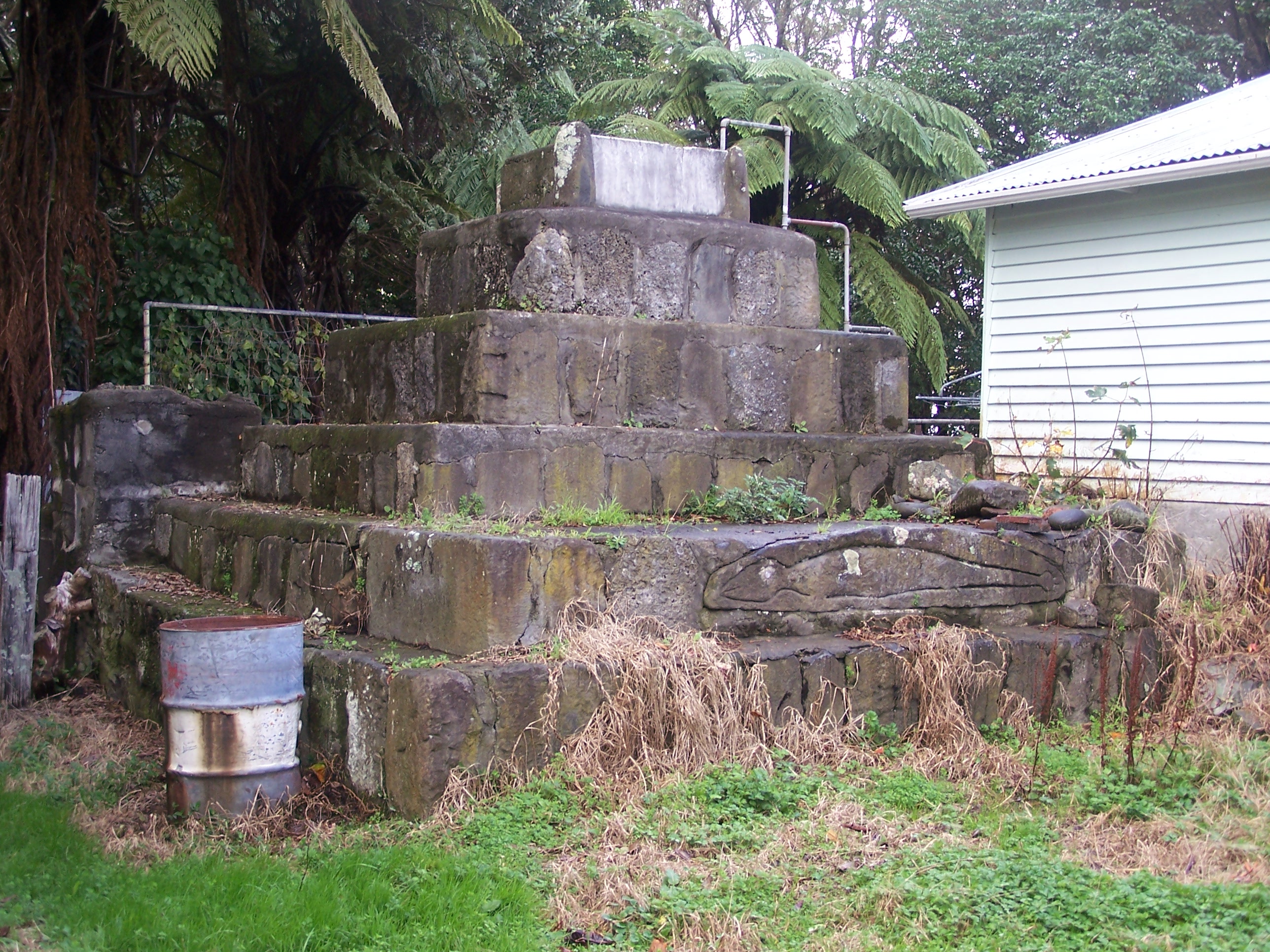
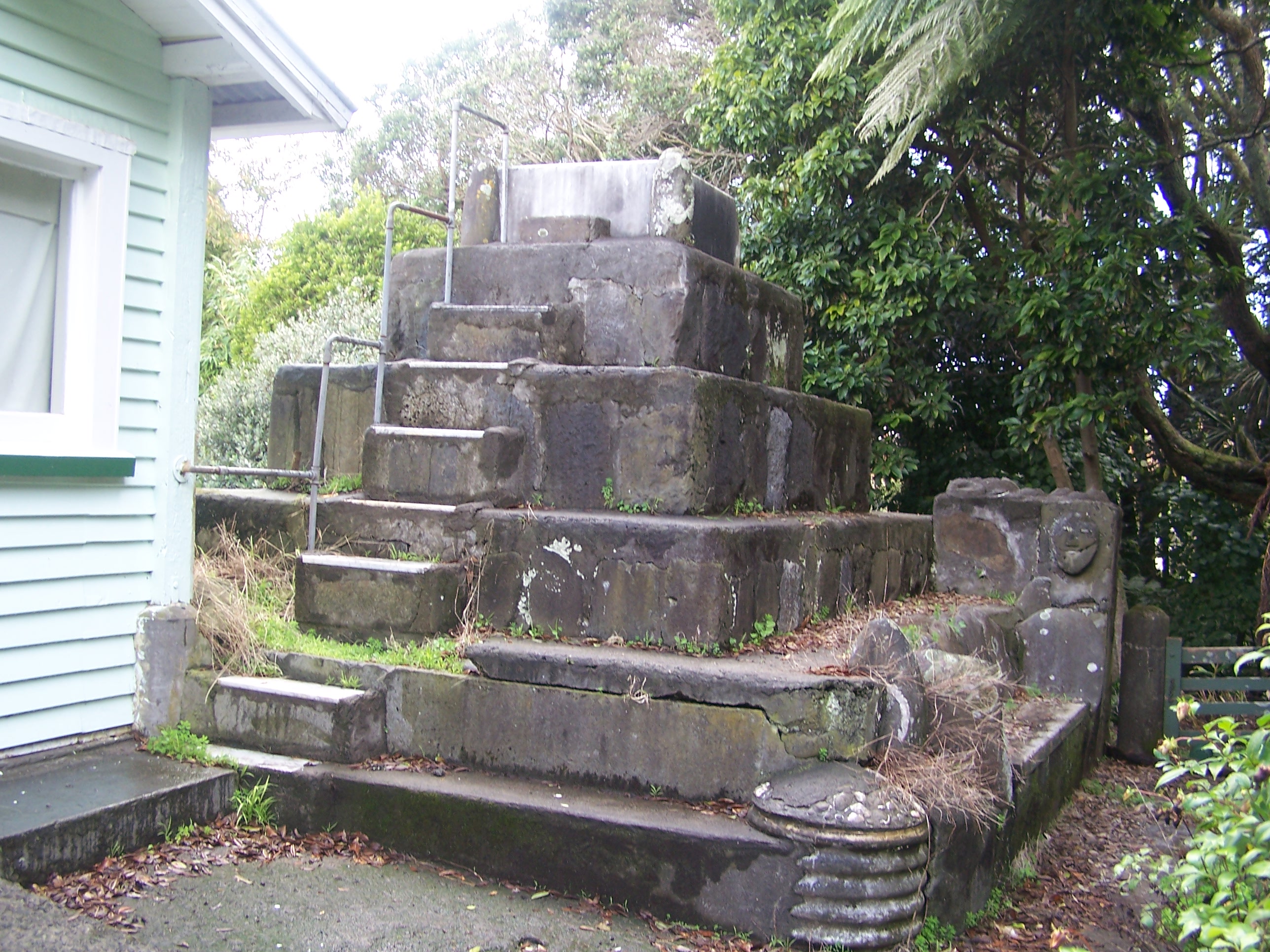
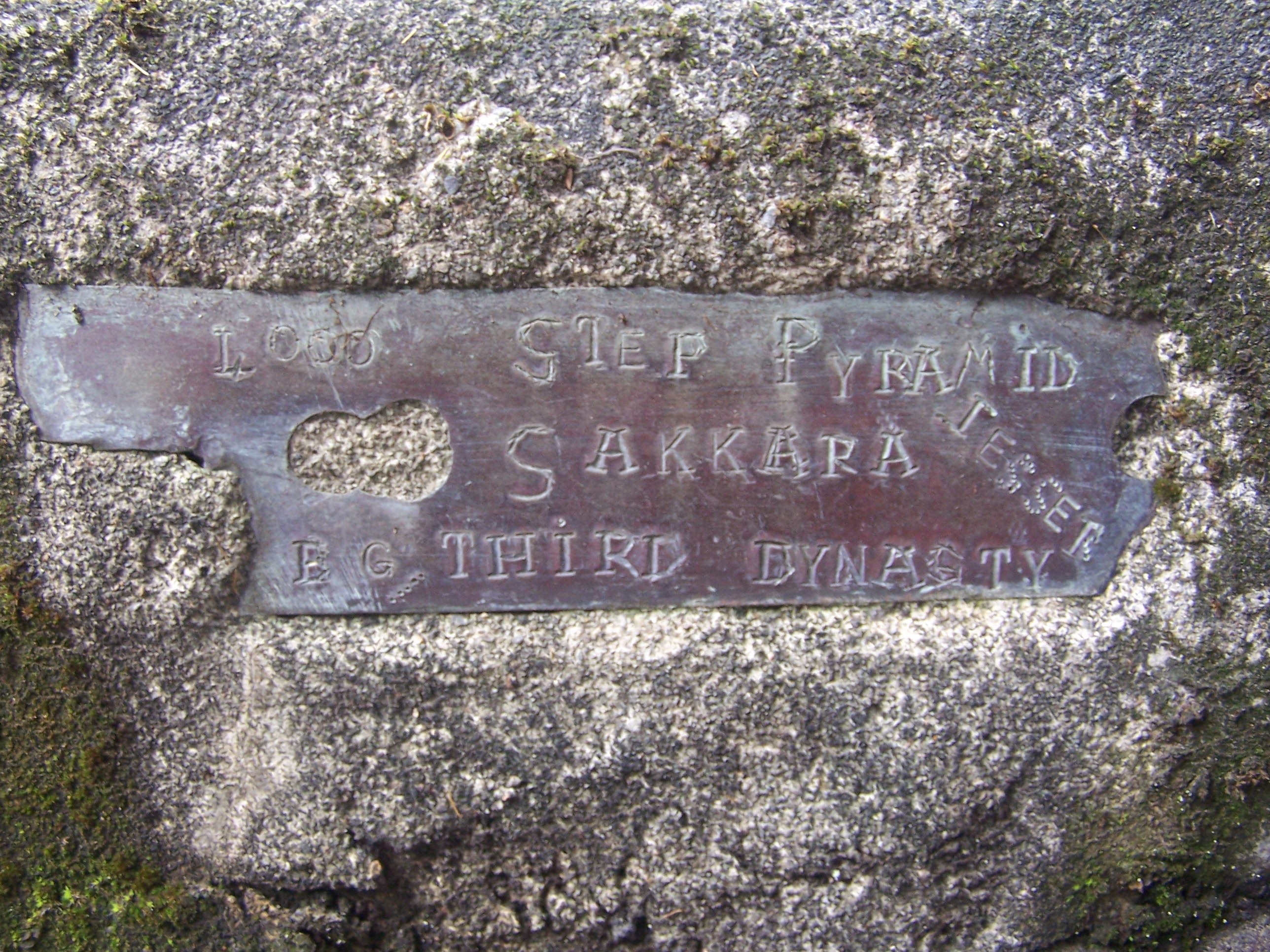
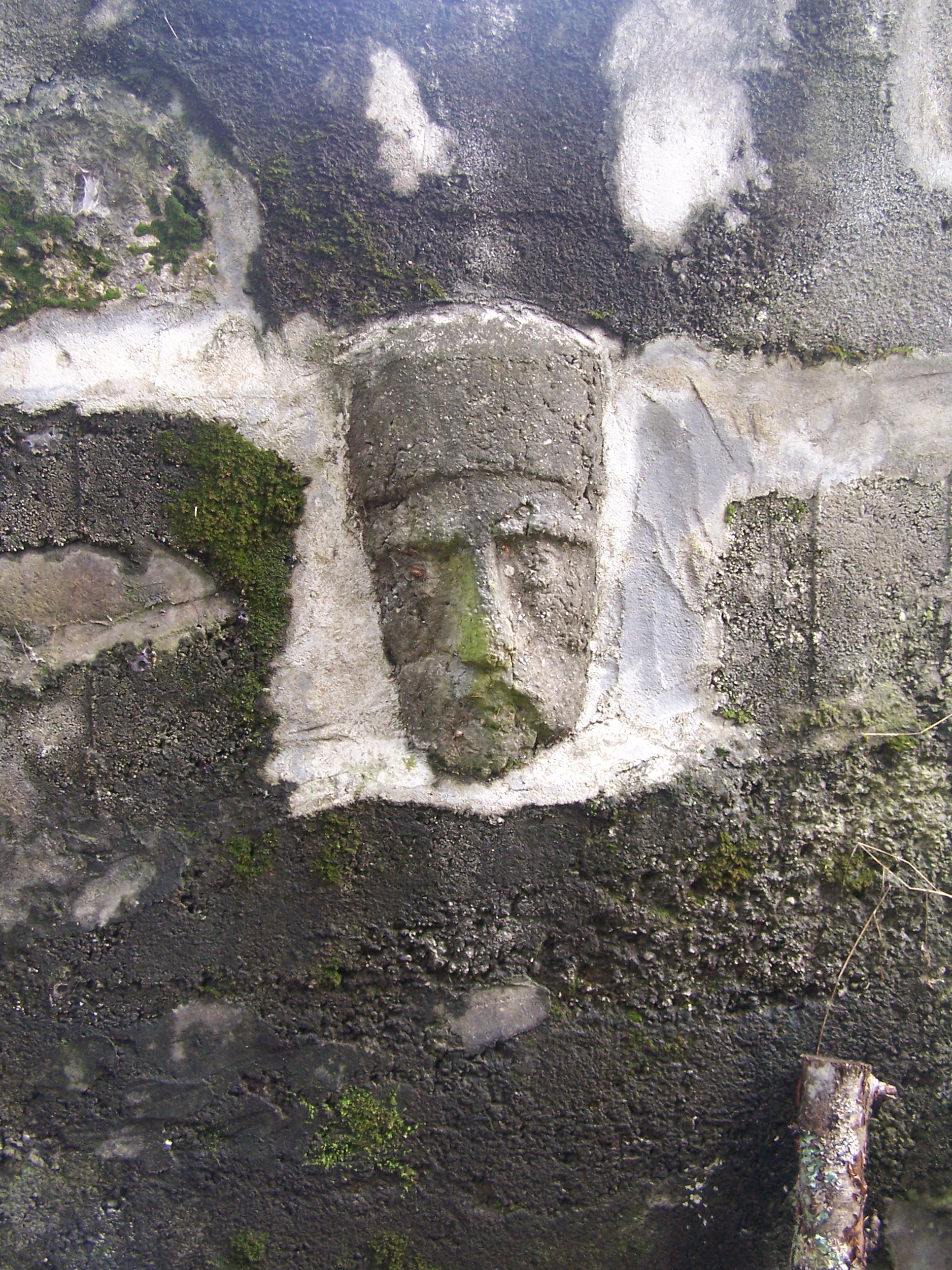
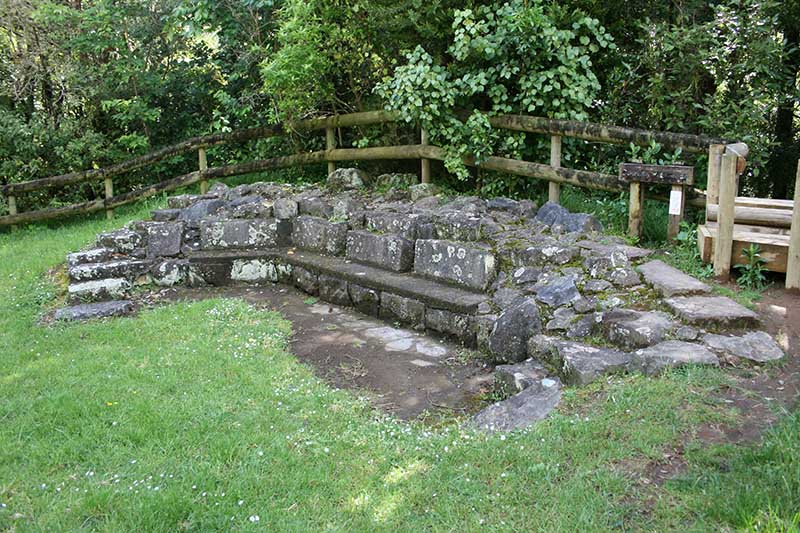
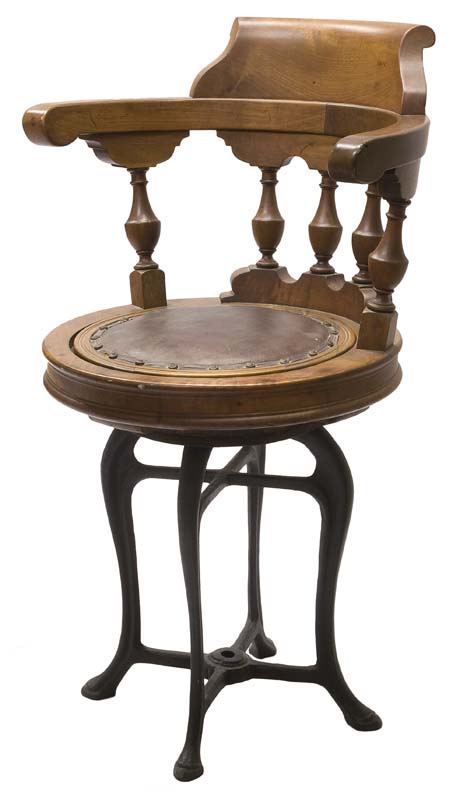
Not everyone has a pyramid in their back yard – but Fred Cowling was not everyone. The New Plymouth man built the five step miniature pyramid, containing several tonne of concrete, as a lookout over his 30 hectare Hurdon farm. "He built it from a photo of a pyramid" says his daughter Dorice Cowling Holmes. "I don't know why he did - it just appealed I suppose. He'd climb it every morning to see if everything was OK."
Fred faced the hulking two metre high pyramid with marble and stone, and added a handrail. Pāua shell and stones were added as decoration. On one side he carved a lizard shape, basking in the sun. Inserted into the side was a little plaque reading: MCMXLIII (1943), the date the pyramid was built.
The pyramid was not the only eye-catching feature at Fred Cowling's Roto Street home. A gigantic grey gate post welcomed visitors to the tree covered property. Next to it a concrete slab that bore the sign ‘Journeys End’. Primitive concrete faces peered out from beneath trees and on walls, guardians of the property. Fred had planted 12 varieties of fruit trees around the farmhouse.
Fred had a love of history and was a great collector of items from Taranaki's past, saving many from being lost forever. His farm, then on the outskirts of New Plymouth, was known to locals as ‘curiosity corner’. Grotesque concrete ‘heads’ balanced on fence posts, in the front yard was a German mine, a collection of old stone rollers, mill stones, bits and pieces salvaged from the Taranaki coastline and Māori artefacts, many of which he later donated to the Taranaki Museum.
Two huge rectangular stones reclined beside the house, Fred had rescued them from a Bell Block beach. The stones had been cut for the foundations of St Mary's Church, but were not needed. The driveway was lined on one side with heavy chains from the ship Warrior that was wrecked at the mouth of the Timaru Stream in 1906. A bowsprit chain from the same ship supported a shelf in the cellar, dug in 1923 to house Fred's homemade wine.
Two cylinders, like giant rolling pins, were mounted on a concrete wall, framing a primitive concrete face. The rollers were hewn from stone between 1845 and 1850 and, according to Dorice, were used after ploughing in preparation for the wheat crops every early settler grew. They were later used to roll the hand–cut metal on the early roads of the province.
An article about Fred Cowling wouldn't be complete without mentioning the Gairloch. The ship has held a special place in the heart of the Cowling family for over 100 years. The shipwreck kick started Fred's love of collecting, and caring for pieces of Taranaki's history.
Fred was only a young man of 17 when the Gairloch ran aground on the Timaru Reef on 5 January 1903. The ship was extensively damaged and deemed unsalvageable. "Dad was working for the Honeyfield’s on the Timaru Road back then" says Dorice. "The shipwreck was a really big event. Not much happened on the Timaru Road."
Most of the Gairloch's cargo, was successfully salvaged, then the ship was left to the locals to scavenge what they could – leaving the rest to the ocean and the elements. On his day off Fred was allowed to take a bullock cart down to the wreck to see if he could find anything useful. He took away with him a cast iron bollard, a porthole, the captain's bridge chair, a brass bulkhead lamp and a brass ring from the captain's cabin door. He set the ring into a stone taken from the beach – the family has used it as a doorstop for the last 100 years.
The shipwreck and Fred's part in it became family lore. An annual pilgrimage to the stranding site became a family tradition. Fred, Mary and their three children would head off to the beach for a picnic. The tradition continued throughout Fred's lifetime and has been carried on by Dorice and her daughters Sherri and Odessa.
Concrete and history were not the only things Fred was interested in – he had a love of New Zealand trees and a fierce passion to protect them and the land they grew on. He'd seen New Zealand move from a forest clad sanctuary for birds, to a country suffering from erosion and dwindling native bird populations due to decimation of the native bush. He lobbied to save bush from being felled and encouraged farmers to plant trees to combat erosion.
Fred put his money where his mouth was – and his land at Westown – long since cleared by pioneer axe and beginning to erode into the Mangaotuku Stream. He planted trees – natives to encourage birds back to the property.
The majestic kauri forests that once stood proudly in Northland had been decimated, so Fred decided to plant his own kauri forest in New Plymouth. He was told it couldn't be done – kauri wouldn't grow so far south – it was too cold. But he went ahead anyway and planted 2000 trees in a block on his farm. Just below the house was another, smaller, kauri plantation. This he called the Mary Rielly Grove, in honour of his wife. "When they were little he had to protect them from the frost and rabbits, and he had to battle the bracken" says Dorice. "But they grew. He proved his point – look at them now!"
In the 1948 Fred donated the two-and-a-half hectares of trees and the little hamlet to the people of New Plymouth. Fred wrote in his diary at the time: "In the days that are to come [this kauri forest] will be one of the greatest scenic attractions of the Southern Hemisphere." Now the trees are an impressive sight, they tower over the landscape and provide haven for many birds and wildlife.
Fred's family were among the first settlers in New Plymouth. His grandfather William Cowling arrived on the first Plymouth Company ship the William Bryan in 1841. He married Mary Hawke who arrived on a later ship and the family settled on a farm at Hurdon, opposite the Hurdon cemetery. The farm stayed in the family for over 140 years, gradually growing smaller as the town crept around it. The little cemetery at Hurdon became a resting place for many of the original settlers to the area, including generations of Cowlings, who only had to be transported across the road.
After working as a farmhand, Fred married Mary and took over the family farm. They moved to Roto Street, where Fred built the family home, then rebuilt it after it burnt down. The Cowling family have always looked after the little cemetery on Tukapa Street. Fred worked as a sexton there, caring for the plots of the town's ancestors. "He dug the graves" recalls Dorice. "He used to sit me on the side of the grave while he was digging them."
Fred finally ended up buried in the Hurdon cemetery next to his ancestors in 1955. Although Fred’s Pyramid has since been dismantled, a memorial seat commemorating his generous gift to New Plymouth can be found in Barrett's Domain. He also left behind a living legacy of trees, one that will last for many hundreds of years.
Please do not reproduce these images without permission from Puke Ariki.
Contact us for more information or you can order images online here.